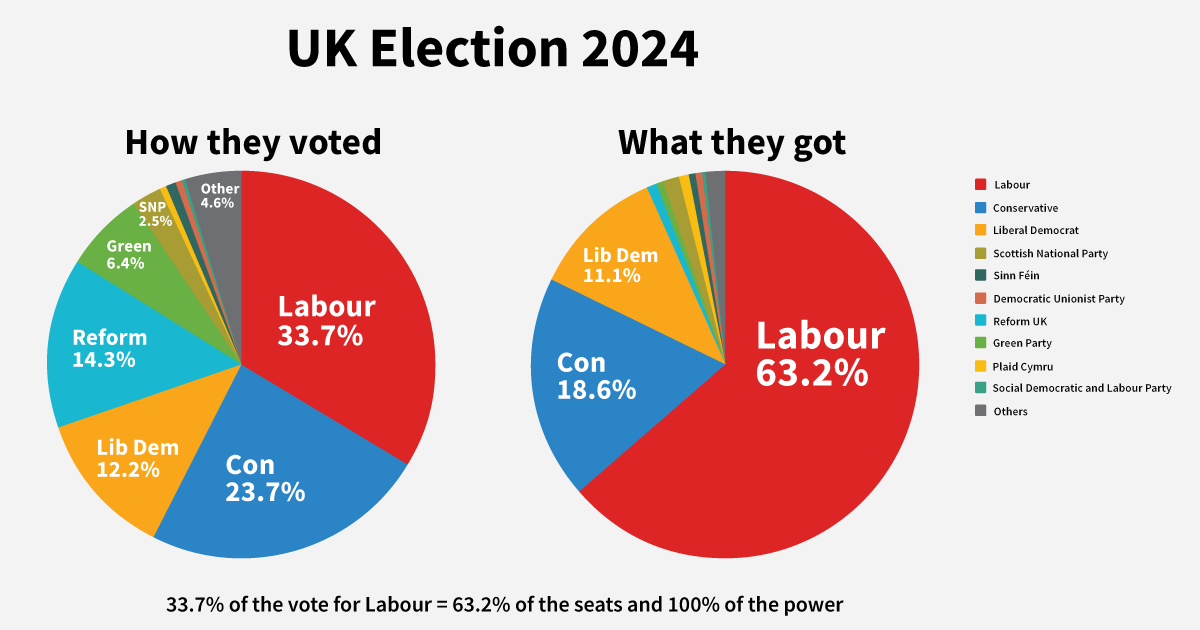4.4 Comparing Systems
There are advantages and disadvantages to each variant of electoral system. Their respective features can produce different types of governments, they might have different degrees of representativeness, or they might pose difficulty in calculating the results.

Composition of the Legislature
Systems that use plurality election systems tend to produce two dominant parties, while proportional systems encourage the formation of smaller parties (Rhodes et al., 2006). Consequently, plurality systems tend to produce governments where one party controls a majority of seats, called a majority government. This is in contrast to proportional systems that tend to see many smaller parties represented in the legislature. It becomes less likely that a single party will control the legislature, which requires the parties to work together and form a partnership, known as a coalition government (Ferland, 1993). These are more common in proportional systems and tend to be less stable than majority governments (Miljan, 2018).
Representativeness
With plurality systems’ emphasis on identifying clear winners in single-member districts, there is sometimes a disconnect with the popular vote. According to the interest group Fair Vote Canada, FPTP systems like Canada and the United Kingdom tend to produce unrepresentative results. In the 2024 UK elections, the Labour Party won over 60% of the seats with less than 34% of the vote.

Image Description
Two pie charts titled “UK Election 2024” compare vote share with seat share among political parties. The left chart, “How they voted,” shows the percentage of votes each party received: Labour (33.7%), Conservative (23.7%), Reform UK (14.3%), Liberal Democrat (12.2%), Green (6.4%), SNP (2.5%), and Others (4.6%). The right chart, “What they got,” displays the corresponding share of parliamentary seats: Labour (63.2%), Conservative (18.6%), Liberal Democrat (11.1%), with other parties having significantly smaller segments. A caption at the bottom highlights the disproportionality: “33.7% of the vote for Labour = 63.2% of the seats and 100% of the power.”
Additionally, the Reform Party earned more votes than the Liberal Democrats, but the Lib Dems won 72 seats compared to the 5 seats won by Reform (BBC News, 2024). A PR system would produce a legislature more in line with the preferences of voters.
Reporting Results
FPTP systems like Canada’s are simple to use and quick to count. Determining control of the legislature is rarely more complicated than counting the votes and reporting the results. Conversely, systems that use preferential ballots or proportional representation can take several days to report the results (Blais & Bol, 2023).
Best of Both Worlds?
Is there a better way of balancing the benefits of each system without the tradeoffs? Perhaps. A Mixed Member Proportional (MMP) system combines elements of FPTP and plurality systems. With a mixed system, voters cast two votes, one for a local representative (typically in a single-member district) and a second vote for a political party. The party votes are allocated to political parties in an attempt to bring the overall election results more in line with the popular vote (Blais & Bol, 2023). New Zealand and Germany use variants of mixed systems.
Changing the System
When a country wants to change some aspect of its electoral system, it is engaged in electoral reform. For example, in 1996, New Zealand changed its electoral system to a Mixed-Member Proportional (MMP) system after a lengthy consultation period (Simpson, 2022).

